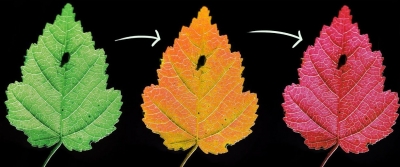
Leaves get their green colour due to the presence of a green pigment called chlorophyll. (You must be aware that leaves use chlorophyll, sunlight, water and carbon dioxide to prepare their food. And this process is called photosynthesis.) But all green leaves also carry a set of yellow and orange pigments called xanthophylls and carotene respectively. Most of the year these colours are mashed by the dominant presence of chlorophyll, the green pigment.
Most trees prepare their food during summer and spring when there is plenty of sunlight, and rest during fall and winter when there is not enough light for photosynthesis. The trees will live off stored food during the winter months.
As chlorophyll does not have much task to perform, trees will stop producing new chlorophyll. The green pigment will start disappearing (or turn less dominant) as chlorophyll breaks down with the onset of fall. And due to this, the yellow and orange pigments become visible.
The lack of sunlight during winter and fall kills off the green, yellow and orange pigments. The leaves will start turning brown in the absence of pigments. This brown comes from a chemical called tannin, which is naturally found in leaves and other parts of a plant.
Picture Credit : Google

